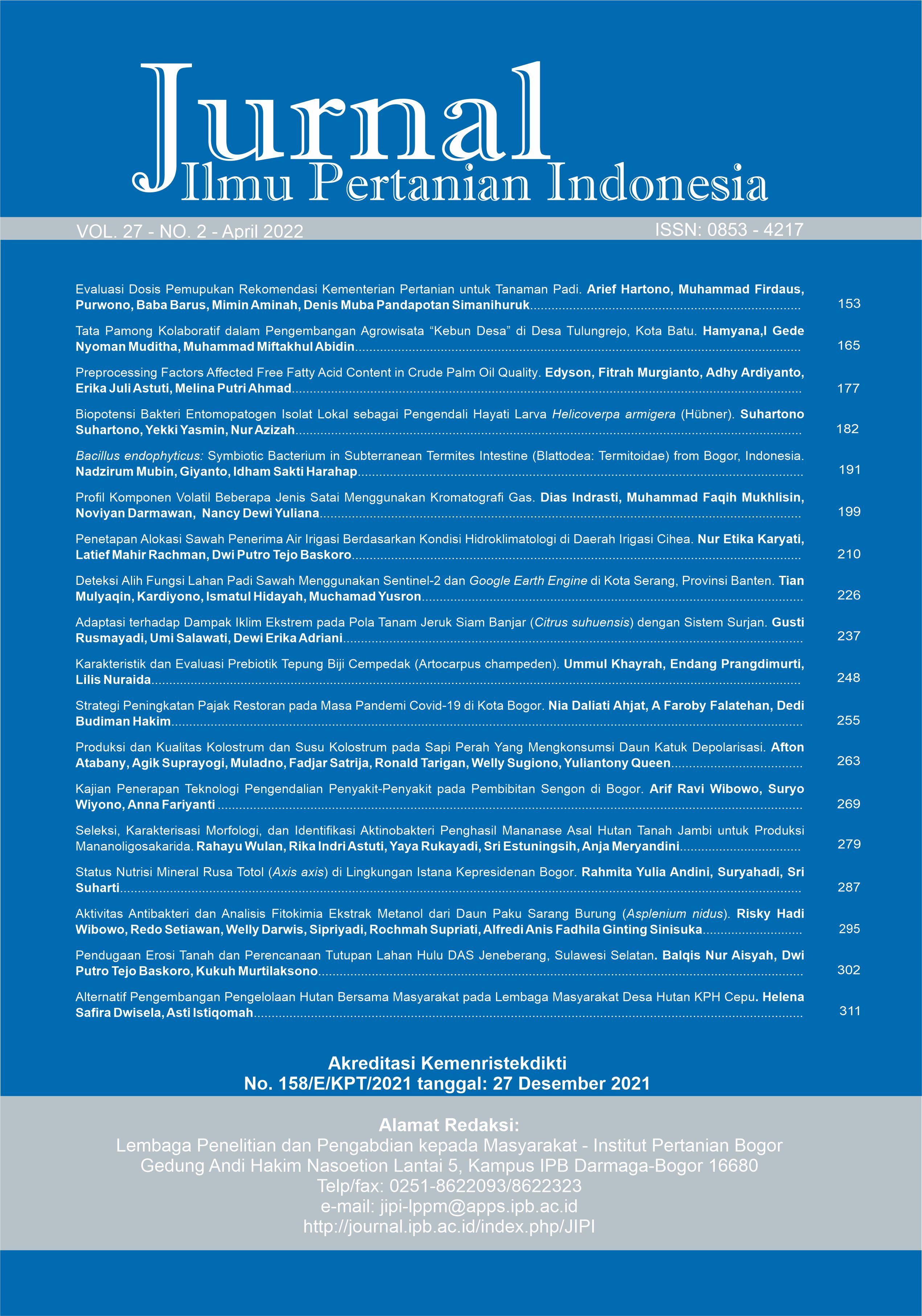Biopotensi Bakteri Entomopatogen Isolat Lokal sebagai Pengendali Hayati Larva Helicoverpa armigera (Hübner)
Abstract
The use of insecticides in the intensive control of Helicoverpa armigera caterpillars increases the environmental deterioration, the natural enemies, and threatening the user's health. The study aims to isolate, characterize, and determine the biological potential of local isolates of entomopathogen bacteria as the biological controlling agent on H. armigera larvae. Bacterial isolation was performed using a serial dilution followed by bacterial macroscopic and microscopic characterizations. A total of eight entomopathogen bacterial isolates were successfully obtained from this study, namely IBE 01, IBE 02, IBE 03, IBE 04, IBE 05, IBE 06, IBE 07, and IBE 08 with diverse morphological characters. The dead larvae generally showed soft, blackish/brownish, smelly, and watery characteristics. Characteristics due to infection with entomopathogen IBE 04 bacteria show the body of larvae that are soft, reddish, and smelly. The treatment of IBE 07 isolates results in the body of the dead larvae being easily ruptured, reddish, and smelly. The percentage of IBE on the mortality of H. armigera larvae is > 50%. The isolates with the highest percentage of killing the larvae were IBE 04 and IBE 07, at 94% and 88%, respectively.
Keywords: biocontrol, larvicide, entomopathogenic bacteria, Helicoverpa armigera
Downloads
References
Bravo A, Likitvivatanavong S, Gill SS, Soberón M. 2011. Bacillus thuringiensis: A story of a successful bioinsecticide. Insect Biochemistry and Molecular Biology. 41(7): 423–431. http://doi.org/10.1016/ j.ibmb.2011.02.006
Dillon RJ, Vennard CT, Buckling A, Charnley AK. 2005. Diversity of locust gut bacteria protects against pathogen invasion. Ecology Letters. 8(12): 1291–1298. http://doi.org/10.1111/j.1461-0248.2005. 00828.x
Direktorat Perlindungan Tanaman Hortikultura. 2008. Pengenalan Dan Pengendalian Hama Tanaman Sayuran Prioritas. Direktorat Perlindungan Tanaman Hortikultura, Jakarta (ID).
Dukare AS, Paul S, Asha AD, Nivetha N, Aggarwal C, Divekar P. 2021. Role of bacterial and fungal chitinases in integrated management of pest and diseases of agro-horticultural crops. In Microbes for Sustainable lnsect Pest Management (pp. 33-57). Springer, Cham.
Jurat-Fuentes JL, Jackson TA. 2012. Bacterial Entomopathogens. Insect Pathology. 265–349. http://doi.org/10.1016/b978-0-12-384984-7.00008-7
Glare TR, Jurat-Fuentes JL, O’Callaghan M. 2017. Basic and Applied Research. Microbial Control of Insect and Mite Pests. 47–67. http://doi.org/ 10.1016/b978-0-12-803527-6.00004-4
Hadioetomo RS. 1993. Mikrobiologi Dasar dalam Praktek. Jakarta (ID): PT Gramedia Pustaka Utama.
Herlinda S. 2005. Bioekologi Helicoverpa armigera (Hübner) (Lepidoptera: Noctuidae) pada tanaman tomat. Agria. 2: 32–36.
Iman M, Tengkano W. 2002. Buku Pegangan Hama Hama Kedelai di Indonesia. Balai Penelitian Bioteknologi dan Sumberdaya Genetik Pertanian. Badan Penelitian dan Pengembangan Pertanian. Jakarta (ID).
Jackai LEN. 1995. Integrated pest management of borers of cowpea and beans. International Journal of Tropical Insect Science. 16(3–4): 237–250. http://doi.org/10.1017/s1742758400017240
James RR, Li Z. 2012. From Silkworms to Bees. Insect Pathology 425–459. http://doi.org/10.1016/b978-0-12-384984-7.00012-9
Kalha CS, Singh PP, Kang SS, Hunjan MS, Gupta V, Sharma R. 2014. Entomopathogenic viruses and bacteria for insect-pest control. Integrated Pest Management. 225–244. http://doi.org/10.1016/b978 -0-12-398529-3.00013-0
Kalvnadi E, Mirmoayedi A, Alizadeh M, Pourian H-R. 2018. Sub-lethal concentrations of the entomopathogenic fungus, Beauveria bassiana increase fitness costs of Helicoverpa armigera (Lepidoptera: Noctuidae) offspring. Journal of Invertebrate Pathology. 158: 32–42. http:// doi.org/10.1016/j.jip.2018.08.012
Krishanti NPRA, Wikantyoso B, Zulfitri A, Zulfiana D. 2017. Bakteri entomopatogen sebagai agen biokontrol terhadap larva Spodoptera litura. Berita Biologi. 16: 13–21. http://doi.org/10.14203/ beritabiologi.v16i1.2153
Krutmuang P, Mekchay S. 2005. Pathogenicity of entomopathogenic fungi metarhizium anisopliae against termites. Conference on International Agricultural Research for Development. Hohenheim: Stuttgart.
Lacey LA. 2012. Manual Techniques In Invertebrate Pathology. London (UK): Academy Press.
Mishra PK, Tandon SM. 2003. Gut bacterial flora of Helicoverpa Armigera (Hub.) (Lepidoptera: Noctuidae). Indian Journal of Microbiology. 1: 55‒56.
Mohan M, Selvakumar G, Sushil SN, Bhatt JC, Gupta HS. 2011. Entomopathogenicity of endophytic Serratia marcescens strain SRM against larvae of Helicoverpa armigera (Noctuidae: Lepidoptera). World Journal of Microbiology and Biotechnology. 27(11): 2545–2551. http://doi.org/10.1007/s11274-011-0724-4
Osborn F, Berlioz L, Vitelli-Flores J, Monsalve W, Dorta B, Rodrı́guez Lemoine V. 2002. Pathogenic effects of bacteria isolated from larvae of Hylesia metabus Crammer (Lepidoptera: Saturniidae). Journal of Invertebrate Pathology. 80(1): 7–12. http:// doi.org/10.1016/s0022-2011(02)00037-x
Patil NS, Jadhav JP. 2015. Significance of Penicillium ochrochloron chitinase as a biocontrol agent against pest Helicoverpa armigera. Chemosphere. 128: 231‒235. http://doi.org/10.1016/j.chemosphere. 2015.01.038
Ravi KC, Mohan KS, Manjunath TM, Head G, Patil BV, Greba DPA, Rao NGV. 2005. Relative Abundance of Helicoverpa armigera (Lepidoptera: Noctuidae) on different host crops in india and the role of these crops as natural refuge for Bacillus thuringiensis Cotton. Environmental Entomology. 34(1): 59–69. http://doi.org/10.1603/0046-225x-34.1.59
Shoda M. 2000. Bacterial control of plant diseases. Journal of Bioscience and Bioengineering. 89(6): 515–521. http://doi.org/10.1016/s1389-1723(00)80049-3
Zulaiha S, Suprapto, Apriyanto D. 2012. Infestasi beberapa hama penting terhadap tanaman jagung hibrida pengembangan dari jagung local bengkulu pada kondisi input rendah di dataran tinggi adisol. Jurnal Penelitian Pengelolaan Sumberdaya Alam dan Lingkungan 1: 15‒28. http://doi.org/ 10.31186/naturalis.1.1.5913
This journal is published under the terms of the Creative Commons Attribution-NonCommercial 4.0 International License. Authors who publish with this journal agree to the following terms: Authors retain copyright and grant the journal right of first publication with the work simultaneously licensed under a Creative Commons Attribution-NonCommercial 4.0 International License. Attribution — You must give appropriate credit, provide a link to the license, and indicate if changes were made. You may do so in any reasonable manner, but not in any way that suggests the licensor endorses you or your use. NonCommercial — You may not use the material for commercial purposes.






















